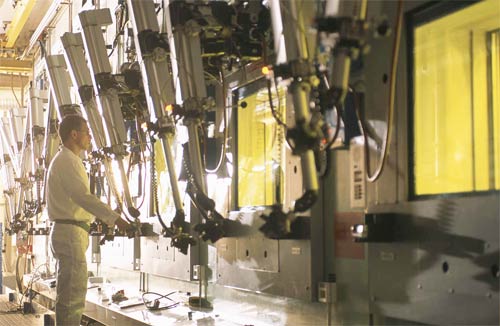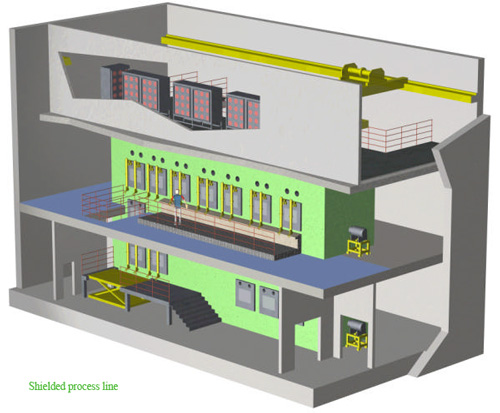Sorting the radioelements in radioactive waste
The separation, or partitioning, of the radioactive materials in spent fuel from reactors is already practised on an industrial scale at La Hague, with the extraction of uranium and plutonium. There are plans to develop partitioning further. ‘Advanced partitioning‘ could be carried out before the transmutation of nuclear waste. It is the first part of research area 1 under the Bataille Act, then the 2006 Act; transmutation is the second.
The aim of partitioning is to reduce the toxicity of high-level waste by removing certain long-lived elements from highly radioactive material and ‘transmuting’ them into stable or short-lived isotopes. Regardless of the outlook for transmutation, sorting radioactive species would make it possible to reduce the radioactivity of packages destined for disposal and make them easier to manage.

Atalante: the study of partitioning processes
Remote manipulation of an irradiated fuel rod in the tank of a shielded process line at the ATALANTE laboratory in Marcoule. In 2004 the line began a series of experiments aimed at demonstrating the technical feasibility of advanced partitioning. To do this, the facility received 15 kg of irradiated fuel. First the uranium and plutonium were partitioned, then the lanthanides and minor actinides, and finally the americium and curium.
© CEA
The radioactive elements to be extracted as a priority are those with heavier nuclei than uranium, i.e. the minor actinides: americium, curium and to a lesser extent neptunium. Attempts will then be made to partition the long-lived fission products, which are less toxic but are mobile, such as iodine-135, technetium-99 and caesium-135. Elements that do not lend themselves to transmutation may be worth conditioning separately.
The research is aimed at developing a range of partitioning processes, for which it will be necessary to demonstrate first the scientific, then the technical and finally the industrial feasibility. This is as yet unexplored territory. After all, who would bother taking an interest in the properties of elements as rare as the minor actinides if they were not in radioactive waste? Large facilities such as the ATALANTE laboratory in France, run by CEA in Marcoule, have had to be set up for this work. ATALANTE is a remarkable facility and currently the only one of its kind anywhere in the world.
One of the main aspects of research into partitioning is choosing extractant molecules with an affinity for the radioactive atom to be selected, which behaves like an ordinary atom until it decays.
At these specialist facilities, molecules are developed and chosen that have affinities for the radioelements to be partitioned. These ‘extractant’ molecules must be selective, choosing only the target species. They must also be able to withstand their environment of highly radioactive solutions, solutions with an activity of around 5 terabecquerels per litre.
per litre.
The partitioning of highly radioactive products is a branch of ‘hot chemistry’. It is a difficult and expensive operation. The ATALANTE teams in Marcoule have found and defined extractant molecules for 15 kg of spent fuel. By the end of 2013, they had demonstrated that the knowledge existed to recover more than 99% of the minor actinides.

Atalante’s ‘shielded process line
The shielded process line built at the Atalante facility is one of CEA’s most important facilities for conducting experiments on radioactive materials. In particular, this equipment allows spent fuel reprocessing techniques to be tested on large quantities over long periods of time. It uses technologies representative of those that would be used on an industrial scale.
© CEA
The transmutation of the minor actinides (neptunium, americium and curium) is envisaged in two very different scenarios, which have implications for the associated partitioning processes.
In the first scenario, the minor actinides would be transmuted in reactors specially designed for this purpose. It would be necessary to keep partitioning the uranium and plutonium, as is done today, and sending them to nuclear power reactors and, in parallel, selectively partitioning the chosen minor actinides for incineration in specially designed reactors. This is the advanced partitioning currently being researched. The Atalante teams working on advanced partitioning in Marcoule have high hopes of proving its technical feasibility.
In the second scenario, the use of fast reactors would enable the minor actinides to be burned efficiently when mixed with standard fuels, producing large amounts of energy. In this case there would be no point in partitioning the minor actinides from the uranium and plutonium because they would be mixed again in the burner reactor. This would require a complete reworking of the current partitioning process, so that if possible all the minor actinides could be extracted in one go with the uranium and plutonium. This is known as group partitioning. Research into this has already begun.
TO KNOW MORE ABOUT PROSPECTS OF WASTE PARTITIONING :
– 1) : Partitioning outlook
Other articles on the subject « Waste Outlooks »
Three research areas
Three complementary research areas The three research areas under the Bataille Act, later supplem[...]
Partitioning: results
Development of processes and extractant molecules The 2006 assessment of research into partitioni[...]
Advanced partitioning
Partitioning of nuclear waste: hot chemistry Advanced partitioning goes beyond just the partition[...]
Area 1: Transmutation
Area 1: Transmuting or transforming radioactive atoms Transmutation is the second part of researc[...]
Transmutation facilities
Fast reactors and Accelerator Driven Systems (ADS) The neutron, which easily penetrates nuclei, i[...]
Transmutation prospects
A far away objective for Generation IV and 2040… At the time of the first tests on the tran[...]
Area 2: Disposal
Research into deep geological disposal Can the nuclear industry’s final waste, which we cur[...]
Area 3: Long Surface Storage
Research into long-term storage Research into long-term storage is the second research topic in a[...]
Long surface storage concepts
Long-term surface and subsurface storage Research into very long-term storage is a matter for the[...]
Area 3: Conditioning
Area 3: Research into conditioning The conditioning of high-level and intermediate-level waste is[...]